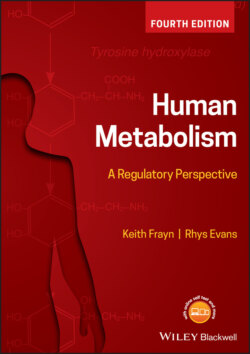Читать книгу Human Metabolism - Keith N. Frayn - Страница 39
1.3.2.1.6 Glycogen metabolism
ОглавлениеCarbohydrate is stored in limited amounts as cytoplasmic glycogen granules in most tissues as an energy resource available within the tissue (and hence independent of blood supply) for rapid utilisation when required. Glycogen is a polymer of glucose whose structure was described earlier (Figure 1.8). Glycogen synthesis starts with glucose 6-phosphate (Figure 1.14) and involves sequential polymerisation of glucose units on a glycogenin protein backbone. Glucose units are added as UDP-glucose (derived from glucose 6-phosphate) to the enlarging glycogen molecule by the enzyme glycogen synthase. Glycogen synthase assembles the glucose units into a linear chain, but every 8–10 residues a branch point is introduced by a branching enzyme. This has the effect of producing a highly branched tree-like structure with many free (‘non-reducing’) ends (Figure 1.8). Glycogenolysis involves the reverse: sequential removal of glucose units. These multiple terminal glucose residues enable rapid glucose release during glycogen degradation, by the enzyme (glycogen) phosphorylase (and a debranching enzyme). Glucose 1-phosphate is released, and is converted into glucose 6-phosphate. In most tissues, which store glycogen for their own utilisation (e.g. muscle), the glucose 6-phosphate then enters the pathway of glycolysis for energy production. In the liver specifically (and to some extent in kidney, especially during starvation) the enzyme glucose 6-phosphatase is expressed (uniquely in these tissues) and converts glucose 6-phosphate to free glucose: thus, glucose derived from glycogenolysis or produced by gluconeogenesis may be released into the bloodstream to maintain blood glucose concentrations in the postabsorptive or the fasting state.
